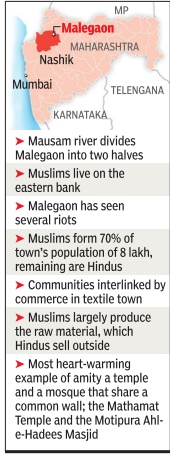Malegaon
This is a collection of articles archived for the excellence of their content. |
The basics\ demography

See graphic:
The demography of Malegaon
YouTube based film industry
Ranjan Dasgupta, January 28, 2023: The Times of India
Mad about movies, Malegaon in north Maharashtra spins out colourful parodies and spoofs that draw as much attention as its power looms that weave gray cotton cloth. A decade ago, Malliwood – Malegaon’s film industry – made the hugely entertaining Malegaon ke Sholay and Malegaon ka Superman, but now it has found a bigger viewership with shorter content on YouTube. At least 10 local groups are making hilarious, memorable products, employing over 1,000 locals, including actors, technicians and other staff.
Akram Khan, 54, is a director and actor from Malegaon. His channels Khandesh Fun and Khandesh Zone have around 8 million and 3 million subscribers, respectively. “We upload a 10-12-minute video. The viewership is huge and it brings us a good income,” he said.
Slapstick and over-the-top episodes shot in Khandeshi, with Chotu Dada as the central character, have legions of fans. Besides original scripts, his spoofs of films like Dabangg and Wanted are popular too. Chotu Dada ki Magic Car, Lockdown Mein Chotu Dada or Chotu Dada Cooker Wala have odd solutions to mundane problems with absurd situations and reactions from the actors. For instance, a real-life enactment of a PUBG game, an impossible situation like getting his bike married, or his weird solution to rising petrol prices. It’s comedy, but not for everyone.
Running On A Shoestring
Malliwood directors and producers say they don’t need much to make the episodes. The equipment is basic – a video camera, an autorickshaw to carry the equipment and a group of 7-8 people, including the actors, for shooting the episodes. With simple sets, nearby locations and local artistes, a day’s shoot costs Rs 60,000-70,000. One episode is shot over 4-5 days, and the earnings from the online platforms are good. “We get paid based on the viewership of episodes and subscribers every month. The social media platform directly deposits the money in our bank accounts. Our artistes are busy throughout the month shooting for new episodes,” Khan said.
Documentary filmmaker Fazia Khan said Malliwood’s use of YouTube is getting them wider viewership and popularity. “Malliwood’s ecosystem was quite different when DVDs were used, films were made for local viewers and distribution was restricted. But the core team in filmmaking remains the same. Producers and directors like Akram Khan are making good use of YouTube,” she added.
Humble Beginnings
Malegaon’s film world took shape in the late 1990s when local artiste Shaikh Nasir decided to make low-budget movies with local youths. His first two movies, including Katil Khazana, played at local video parlours but got a poor response. Undeterred, he made Malegaon ke Sholay, a spoof on a budget of around Rs 50,000, including fees for the actors and technicians.
The movie was made in Khandeshi. Gabbar became Rubber and Basanti Basmati. “We used VCR cameras and edited the movie ourselves. When it played, it was a roaring success,” Nasir recalled.
Other spoofs followed – Malegaon ka Shaan, Malegaon ka Rangeela, Malegaon ke Karan Arjun, but none gained the same popularity. When Nasir began making Malegaon ka Superman, it caught Mumbai-based filmmaker Faiza Ahmad Khan’s attention.
She had heard about Malliwood making low-budget films and spoofs of big-budget movies. Khan made a documentary that captured the passion Malegaon locals have for making movies. At that time, approximately 300 local artistes and technicians were involved and the budgets ranged from Rs 20,000 to Rs 40,000 per film.
Malegaon’s movies faded around 2015, when TV serials, OTT and shorts on smartphones became more popular.
Search For New Audience
Khan was among the first in Malegaon to make spoofs and upload them on social media platforms. “It has given our industry a fresh lease of life, boosting our confidence to try new ventures, even if it means bigger investments,” he said.
He now plans to set up an office in Mumbai and tie up with firms involved in streaming movies, crime thrillers, and short advertisements on OTT platforms.
Inspired by Khan, Shaikh Malik Shaikh Rashid ventured into filmmaking about six months ago. He said the episodes he has made are hugely popular. “In the last six months our episodes on Chotu ke Kabutur and Chotu Army ki Diwali have a viewership of over one crore.”
Shaikh has planned a 200-episode serial based on a love story: “Our plan is nascent. With the confidence that I gained in making small episodes in Malegaon, my plan to make a serial for a TV channel will work.”
Small Star Shines Bright
Malliwood’s most sought-after hero is 30-year-old Sheikh Shafique. Producers and directors wait for Shafique or Chotu Dada’s availability to plan their schedules for shooting episodes.
Shafique had a hard life. His short height made him the butt of jokes to the extent that he never left home and hardly interacted with anyone. “He slid into depression and his parents were extremely worried,” recalled Khan, who spotted him in a video and decided to make him the central character of his first venture ‘Khandesh ka Dada, Mumbai ki Radha’. It was a comedy based on a love story which ran for 72 episodes.
Since Shafique cannot read or write, the dialogues are narrated to him and he memorises them before the shoot. “Khan sir changed my fortune. He gave me a break that made me emotionally and financially stable. It feels good that viewers watch my movies,” Shafique said.
Poonam Patil, a lead actor working with Shafique, said they have financial stability and immense popularity in India and overseas. “Now, I have started two channels, Gundi Official and Gundi ki Comedy, which have a viewership of over 4-5 million. Malliwood is on a firm footing.”